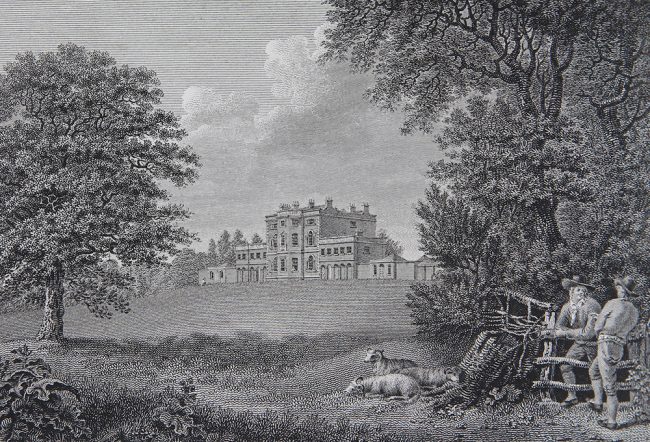
A 1792 engraving of the house from "Angus's Views of Seats." By kind permission of a private collection.
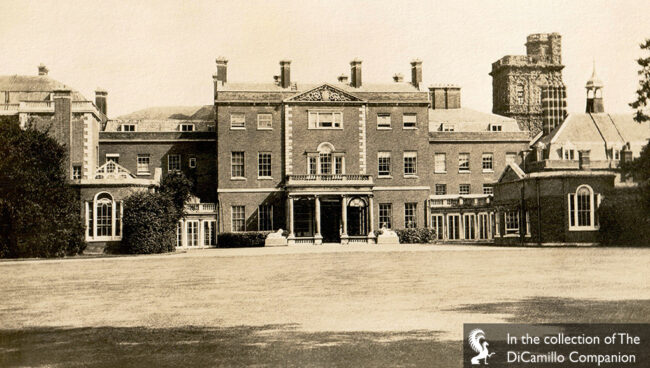
The entrance facade from a circa 1908 postcard
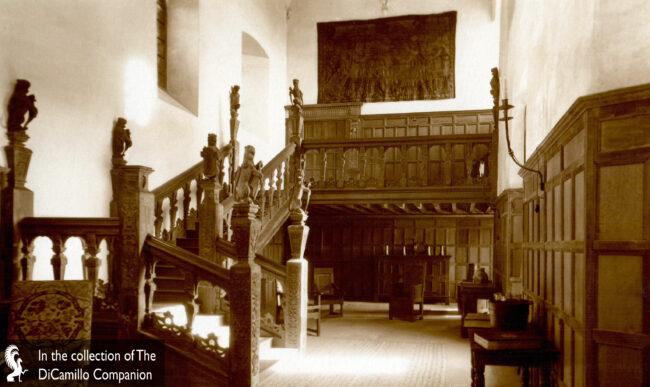
The Great Staircase (oak) from Theobalds Palace (today at Herstmonceux Castle). From a circa 1914 postcard.
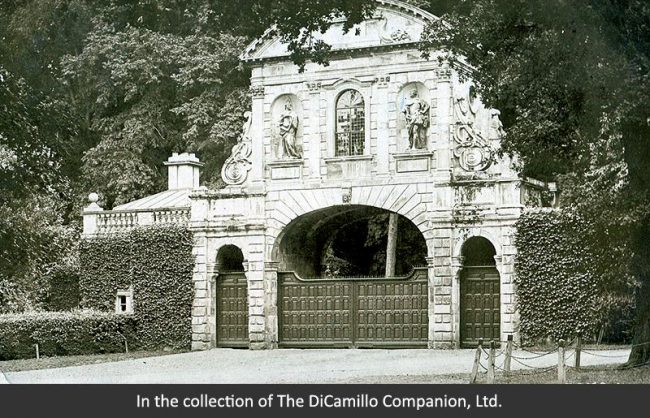
The Temple Bar as a Theobalds gatehouse. From a 1909 postcard.
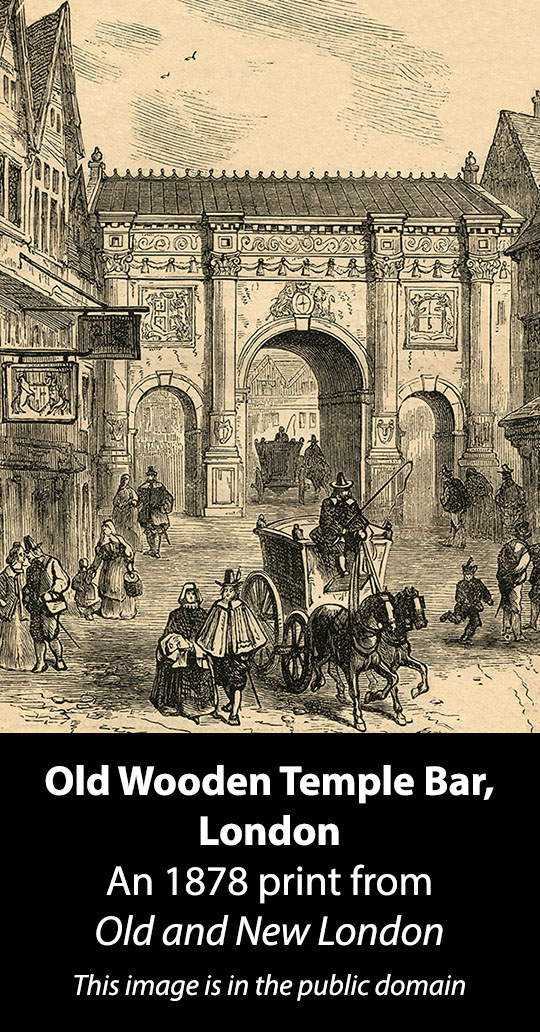
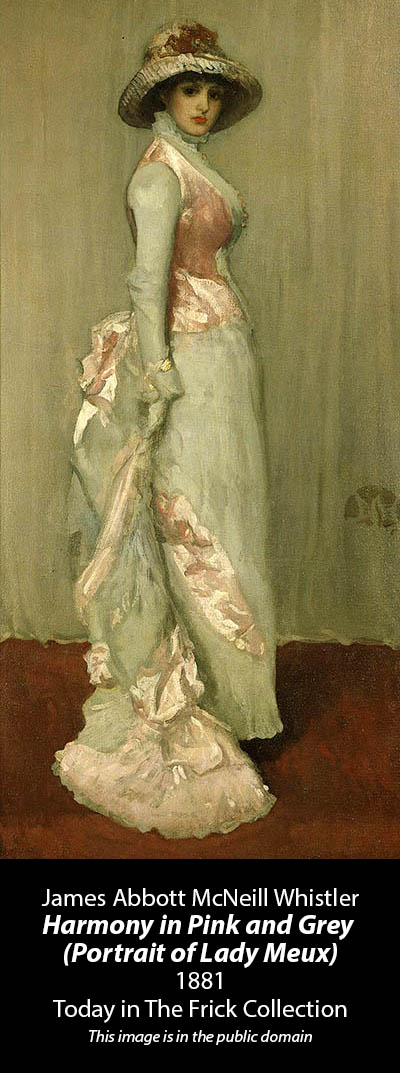
Built / Designed For: George Prescott
House & Family History: Theobalds Park is a red brick and Portland stone house of five bays by two-and-a-half stories with small outer wings and forward-curving one-story colonnades. The Theobalds Estate (site of the former Theobalds Palace) was purchased from the 3rd Duke of Portland by George Prescott in 1763. It was Prescott who built the current 18th century house, later enlarged by the Meux family in the 19th and early 20th centuries. Theobalds Park is noted for its very fine entrance hall in the Etruscan style. In the late 19th century Theobalds Park was the home of the infamous Lady Meux. Born in America as Valerie Susan Langdon, Lady Meux claimed to be an actress, but was actually a banjo-playing barmaid and prostitute in London when she met Sir Henry Bruce Meux, 3rd Bt. (1856–1900), scion of one of England’s wealthiest brewing families. In 1878 Sir Henry married Valerie and encouraged and supported her flamboyant lifestyle (e.g., she drove herself around London in a phaeton drawn by a pair of zebras). In 1881 Sir Henry commissioned Whistler to paint three portraits of his wife: “Harmony in Pink and Grey (Portrait of Lady Meux)," today in The Frick Collection (see “Images” section); “Arrangement in Black: Lady Meux” is owned by the Honolulu Museum of Art; the third portrait, “Portrait of Lady Meux in Furs,” is believed to have been destroyed by Whistler after he became upset over a comment made to him by Lady Meux during a sitting. During the Second Boer War (1899-1902) the Battle of Ladysmith made a particular impression on Lady Meux, who personally paid for six 12-pounder naval guns to assist the war effort. When Admiral Hedworth Lambton, commander of the naval brigade at Ladysmith, returned to England, he visited Lady Meux at Theobalds to thank her for her gift. She was so impressed with the admiral that she made him the beneficiary of her will, on condition that he change his name to Meux. Accordingly, at her death in 1910, he legally changed his surname and inherited Theobalds and a large part of Meux's Brewery Company, all of which he owned until his death in 1929. Between 1929 and 1937 Theobalds was a hotel. In 1938 Middlesex County Council purchased the house for use as a general hospital; however, before the conversion to a hospital could take place, World War II erupted. During the war Theobalds was used by the Royal Artillery and the Metropolitan Police Riding School. After the war the county council used the house as a school, a purpose it served from 1951 until 1969, when the school closed. In the 1970s and 1980s Theobalds was an adult education center. In 1995 Theobalds Park was restored as a conference center and hotel, a purpose it served until 2023, when Birch Cheshunt Hotel closed and the house and 55 acres were listed for sale. What is believed to have been the great staircase from Theobalds Palace (see "Images" section) was, at one time, installed at Theobalds Park (since the early 20th century the staircase has been installed at Herstmonceux Castle).
Collections: Lady Meux was an important collector of ancient Egyptian artifacts, which were documented by the noted Egyptologist Wallis Budge in “The Book of Paradise,” which cataloged more than 1,700 pieces in her collection, including 800 amulets and scarabs. Her planned bequest of the collection to the British Museum was turned down by the museum’s trustees, very likely because of Lady Meux’s background. She also acquired five illustrated ancient Ethiopian manuscripts that were purchased after her death by William Randolph Hearst. In 1911 Admiral Lambton sold the contents of Theobalds Park at auction.
Garden & Outbuildings: Located on the Strand, just before it becomes Fleet Street, Temple Bar was a gateway to the City of London. A bar is first recorded here in 1293—probably just a chain between wooden posts. Due to its proximity to the Temple Church (a 12th century church that was once the English headquarters of the Knights Templar), the area came to be called Temple, which is how the bar got its name. It was here that guilds of lawyers came together and ultimately formed the Inns of Court, making the area the center of English law. In the 14th century the earlier bar was replaced by a large wooden gateway with the additional feature of a prison above the gate! Much like an ancient Roman triumphal arch (though significantly less grand), the Temple Bar was the centerpiece for victorious kings who returned from battle and celebrated their victories under its arches. The bar’s grandest moment may have been in 1588, when Queen Elizabeth I processed under the bar as part of the celebrations for the defeat of the Spanish Armada. The second Temple Bar survived the Great Fire of 1666, but was neglected and semi-ruinous by the time Charles II ordered its rebuilding in Portland Stone in 1672, very likely to the designs of Christopher Wren (see "Images" section). The king clearly intended the new bar to be a monument to the Stuart dynasty, as it features four life-sized stone statues of the Stuarts: James I and his wife, Anne of Denmark, and Charles I and Charles II. In the 1870s, when the Royal Courts of Justice were being built and the road needed to be widened, the Temple Bar was removed from its ancient spot. This was not, however, a demolition, but a “saving.” Between January 2 and 13, 1878 the bar was taken down, stone-by-stone, and stored away. In 1880, in its place, was erected the Temple Bar Memorial, which sits on an island the middle of the road across from the Royal Courts of Justice. Sitting on an elaborate granite pedestal is the statue of a dragon rampant bearing the shield of the arms of the City of London. The pedestal features free-standing bronze statues of Queen Victoria and her son, the Prince of Wales, the last royals to have entered the City through Wren's gateway. In 1887, at Lady Meux's request, the Temple Bar, still in pieces, was purchased from the City of London Corporation and transported to Theobalds, where, in 1889, it was re-erected as a new gateway to the estate. Here Lady Meux entertained the great and good of the day, including the Prince of Wales (later Edward VII) and the young Winston Churchill, in the Temple Bar's upper room. In 1984 the Temple Bar Trust purchased the gateway from the Meux Trust for £1 and proposed its re-erection beside St. Paul's Cathedral as part of the Paternoster Square redevelopment. The Temple Bar was carefully dismantled and sent on 500 pallets to the City of London, where it was re-erected as an entrance to Paternoster Square and opened to the public on November 10, 2004. Temple Bar is today the only surviving gateway to London. Theobalds Park is today set in 55 acres of grounds.
Architect: Charles Edwin Ponting
Date: Early 20th century
Title: SPAB News
Author: NA
Year Published: NA
Reference: Vol 23, No. 4, pg. 12
Publisher: London: The Society for the Protection of Ancient Buildings
ISBN: NA
Book Type: Magazine
Title: Buildings of England: Hertfordshire, The
Author: Pevsner, Nikolaus; Cherry, Bridget
Year Published: 2000
Publisher: London: Penguin Books
ISBN: 0140710078
Book Type: Hardback
House Listed: Grade II*
Park Listed: Not Listed
Past Seat / Home of: George Prescott, 18th century. Sir Henry Meux, 2nd Bt., until 1883; Sir Henry Bruce Meux, 3rd Bt., 1883-1900; Meux family here 1820-1910. Admiral of the Fleet Sir Hedworth Lambton, 1910-29.
Current Ownership Type: Corporation
Primary Current Ownership Use: Unoccupied
House Open to Public: No
Historic Houses Member: No